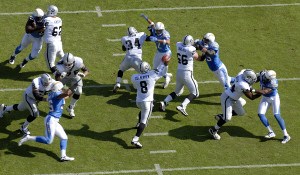A group of University of Rhode Island students have been jumping up and down for weeks on a variety of playing surfaces in a study to evaluate how each affects athletic performance and injury potential.
Disa Hatfield, URI assistant professor of kinesiology, said little is known about whether athletes perform better or are more susceptible to injury on the various surfaces.
“People make decisions all the time that amount to spending thousands of dollars to buy artificial turf or to plant one kind of grass or another, but those decisions are based mostly on cost,” Hatfield said. “We think this study will answer a lot of important questions, especially about injury risk.”
Hatfield and her students are testing four surfaces – a hard metal plate, artificial turf like that used in many National Football League stadiums, and grass planted on either a sandy loam soil or on peat soil.
The surfaces are being tested using 42 volunteer subjects who are asked to jump in five different ways to measure the height of each jump, the power they produce, and their landing pattern. According to Hatfield, jumping height and power directly correlate to athletic performance.
The volunteers are also filmed so the researchers can examine the angles of their legs, knees and ankles as they land to analyze injury risk.
“We expect performance to be a little better on the artificial turf, but we may also get more ankle and knee movements on the landing because of the harder impact,” she said.
Hatfield said that many people, especially women, experience knee valgus – their knees cave inward upon landing – which is associated with a high risk of anterior cruciate ligament (ACL) injury.
“When we see knee valgus to a certain degree, that’s a serious risk factor for injury,” she said.
The study is particularly timely because of increasing concern, especially in the NFL, about the high prevalence of injuries on artificial turf.
“The problem is that maintaining artificial turf is much cheaper and easier than maintaining live grass. The cost factor is much less,” she said. “But I’m hoping that we’ll be able to show a decreased injury risk on natural surfaces, which have a higher capacity to absorb impacts.”
While the professional athletic venues may be one driver of the research, Hatfield believes her data will be equally useful to recreational venues where the majority of amateur and recreational athletes exercise and compete.
“Most of those venues aren’t going to be investing in an artificial surface, but they will want to know what we learn about the differences between soil types,” Hatfield said. “There is some speculation that because sand is denser and doesn’t bend as much, injury potential will be higher, but there is no research yet to verify that.”
Hatfield will spend the summer and fall analyzing the data that is being collected this spring, and she hopes to have results to report at the end of the year.
Her research was funded in part by the New England Regional Turfgrass Foundation and with guidance from turfgrass scientists W. Michael Sullivan at URI and Jason Henderson at the University of Connecticut.
Source: University of Rhode Island
Was this article valuable?
Here are more articles you may enjoy.


 The Return Period for An LA Wildfire-Scale Event May Be Shorter Than You Think
The Return Period for An LA Wildfire-Scale Event May Be Shorter Than You Think  Billionaire NFL Owner Suing Over Billboards Near His SoFi Stadium
Billionaire NFL Owner Suing Over Billboards Near His SoFi Stadium  First Brands Judge Approves Examiner to Probe Fraud Allegations
First Brands Judge Approves Examiner to Probe Fraud Allegations  Tesla, EEOC Plan Talks to Settle Factory Racism Suit
Tesla, EEOC Plan Talks to Settle Factory Racism Suit 